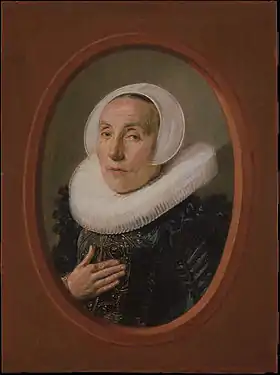Petrus Scriverius
Petrus Scriverius, the Latinized form of Peter Schrijver or Schryver (12 January 1576 – 30 April 1660), was a Dutch writer and scholar on the history of Holland and Belgium.

He was born at Haarlem, and educated by Cornelis Schoneus at the University of Leiden, where he formed a close intimacy with Daniel Heinsius.[1] In 1599 he married Anna van der Aar, and from 1611 to 1613 he was headmaster of the Latin School in Duisburg, today's Landfermann-Gymnasium. He belonged to the party of Oldenbarnevelt and Grotius, and brought down the displeasure of the government by a copy of Latin verses in honor of their friend, the Remonstrant Leiden pensionaris Rombout Hoogerbeets.[1] Scriverius' poems were considered libelous and he was fined 200 guilders, but when the councilmen came to collect, Scriverius directed them to the kitchen to collect pots and pans, which were not worth enough money. His wife then directed the gentlemen to the books in the library, claiming that it was the books that caused her husband to write the poems, so proceeds from a book sale should pay for the fine on them.[2] Scriverius and his wife enjoyed a long marriage of 57 years and had at least 8 children. Their portraits were painted on the occasion of their 25th wedding anniversary by Frans Hals.

Most of his life was passed in Leiden, but in 1650 he became blind, and the last years of his life were spent in his son's house at Oudewater, where he died in 1660.[1]
He is best known as a scholar by his notes on Martial, Ausonius, the Pervigilium Veneris; editions of the poems of Joseph Justus Scaliger (Leiden, 1615), of the De re militari of Vegetius Renatus, the tragedies of Seneca (P. Scriverii collectanea veterum tragicorum, 1621), &c. His Opera anecdota, philologica, et poetica (Utrecht, 1738) was edited by A. H. Westerhovius, and his Nederduitsche Gedichten (1738) by S. Dockes.[1]
He made many valuable contributions to the history of Holland: Batavia Illustrata (4 parts, Leiden, 1609); Corte historische Beschryvinghe der Nederlandscher Oorlogen (1612); Inferioris Germaniae . . . historia (1611, 4 parts); Beschryvinghe van Out Batavien (Arnheim, 1612); Het oude Goutsche chronycxken van Hollandt, as editor, and printed at Amsterdam in 1663; and Principes Hollandiae Zelandiae et Frisiae (Haarlem, 1650), translated (1678) into Dutch by Pieter Brugman.[1]
See also Peerlkamp, Vitae Belgarum qui latina carmina scripserunt (Brussels, 1822), and J. H. Hoeufft, Parnassus latino-belgicus (Amsterdam, 1819).[1]
Marriage pendant portraits by Frans Hals
 Portrait of Petrus Scriverius
Portrait of Petrus Scriverius Portrait of Anna van der Aar
Portrait of Anna van der Aar
References
-
 One or more of the preceding sentences incorporates text from a publication now in the public domain: Chisholm, Hugh, ed. (1911). "Schrijver, Peter". Encyclopædia Britannica. 24 (11th ed.). Cambridge University Press. p. 378.
One or more of the preceding sentences incorporates text from a publication now in the public domain: Chisholm, Hugh, ed. (1911). "Schrijver, Peter". Encyclopædia Britannica. 24 (11th ed.). Cambridge University Press. p. 378. - Anna van der Aar on historici.nl
External links
 Media related to Petrus Scriverius at Wikimedia Commons
Media related to Petrus Scriverius at Wikimedia Commons